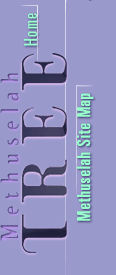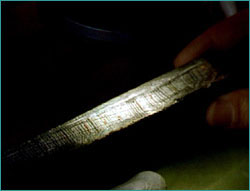|
 |
 |
|
Build a Tree-Ring Timeline
by Rick Groleau
Assessing the age of a living tree is straightforward enough—just extract a core from the tree's circular trunk and count the number of lines in the core formed by the tree's annual growth rings. (The rings of ancient bristlecone pines like Methuselah are more challenging to count, because the trunks are so distorted that new rings may form at right angles to ones formed long before.) But there's much more information to be gleaned from growth rings than simply a tree's age. This information comes to us through the science of dendrochronology.
 Tree rings can reveal more than just a tree's age.
Tree rings can reveal more than just a tree's age.
|
|
A dendrochronologist studies growth rings to determine dates and environmental conditions of the past. The basis of the science lies in a tree's unique pattern of growth rings, which acts as a kind of fingerprint. Every year a new ring is added to a tree's trunk and branches, just beneath the bark. The thickness of this ring depends on how much the tree grows during the year—favorable growing conditions result in a fat ring, unfavorable conditions in a narrow ring. And because trees in a given area generally experience the same growing conditions, those trees have similar tree-ring patterns.
By starting with a living tree and using wooden objects of different ages, dendrochronologists can work back through time and create a continuous plot of tree rings for a specific area. These plots can stretch back hundreds, sometimes even thousands, of years. They then use these tree-ring chronologies to date wooden objects, to determine a general area in which the wood grew, and to find out about past climates.
This Hot Science lets you assemble your own tree-ring chronology. You'll start with a tree-ring sample from a living tree and, using other samples, piece together a pattern of rings that stretches back through time.
Build a Tree-Ring Timeline
requires the Shockwave plug-in
Anatomy of a Tree Ring
Growth and Sensitivity
Skeleton Plots
Shockwave is a plug-in that allows for increased interactivity. If you can see
the animated boxes at left, the plugin is already installed. If you do not see
the boxes, you can install the Shockwave plugin.
Rick Groleau is managing editor of NOVA Online.
A slightly different version of this feature appeared on NOVA's "Vikings" Web site, www.pbs.org/nova/vikings/.
Photo credits
Explore the Methuselah Grove |
A Tree's Secret to Living Long
Build a Tree-Ring Timeline |
Illuminating Photosynthesis
Resources |
Teacher's Guide |
Transcript |
Site Map |
Methuselah Tree Home
Search |
Site Map |
Previously Featured |
Schedule |
Feedback |
Teachers |
Shop
Join Us/E-Mail |
About NOVA |
Editor's Picks |
Watch NOVAs online |
To print
PBS Online |
NOVA Online |
WGBH
© | Updated November 2001
|
|
|
|